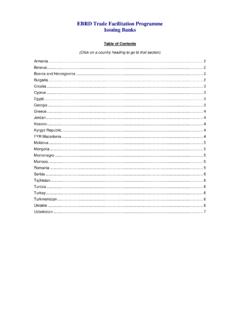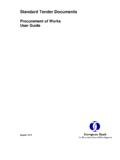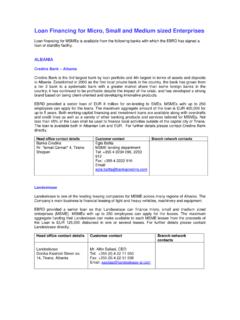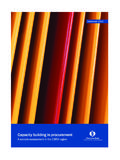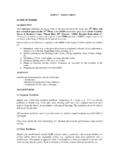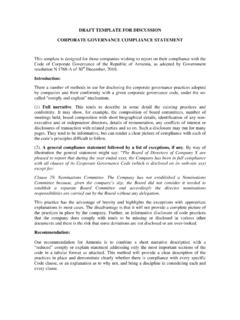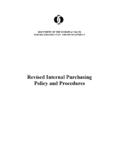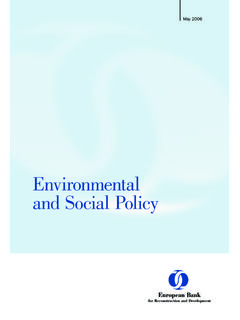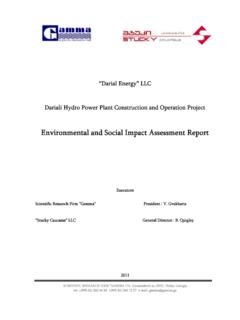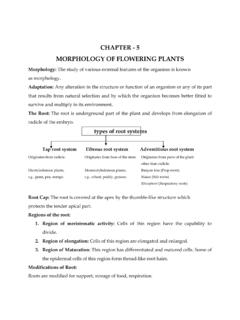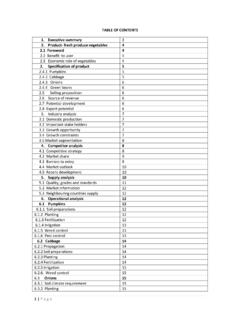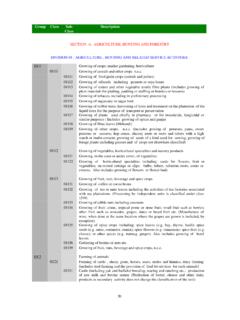Transcription of EBRD Environmental and Social Risk Categorisation List ...
1 EBRD Environmental and Social Risk Categorisation List Revised 2014 This checklist is designed to provide credit officers within Financial Institutions (FIs) with a guide to the typical level of inherent Environmental and Social risk related to particular business activities. This, in turn, should help, credit officers in judging the appropriate level of Environmental and Social risk assessment that should be carried out. A bank s actual exposure to financial, legal and reputational risks (stemming from Environmental and Social issues) will also depend upon other factors such as the nature and size of the transaction and the financial and managerial capacity of the company to effectively manage Environmental and Social issues. These factors should be taken into account when using this checklist. Refer to EBRD s industry sub-sectoral guidance documents which provide a summary of the Environmental and Social issues and risks associated with the industry concerned ( ).The checklist may also prove valuable for reporting portfolio level exposures to particular industries, when completing the annual EBRD Sustainability Index.
2 EBRD Environmental and Social Risk Categorisation List Revised 2014 Page 2In addition to high, medium and low risk the list attached also shows further categories which include the following:Business activities are ranked according to the EU statistical classification codes NACE Rev. 2 (based on the Regulation (EC) No 1893/2006 of the European Parliament and of the Council, establishing the statistical classification of economic activities NACE Rev. 2, adopted on 19 December 2006).For further sector descriptions, please click on underlined Category and Subcategory refers to (i) any temporary or permanent changes to the landscape, atmosphere, soil, water, plants or animals caused by human includes (i) labour standards and terms of employment (ii) community impacts such as public health, safety, security, gender equality, impacts on indigenous peoples and cultural heritage, land acquisition or potential reduction in people s livelihoods as a result of project activities (iii) occupational Health and Safety.
3 It also includes disproportionate impacts on vulnerable groups/gender, involuntary resettlement, and affordability of basic rating reflects a balanced assessment of the combined Environmental and Social risks associated with the industry Activity RiskThe customer's business activities may give rise to significant or long-term Environmental and Social risks and impacts. These may require more specialised risk assessment, and the customer may not have the technical or financial means to manage Activity RiskThe customer's business activities have limited Environmental and Social risks and impacts, and these are capable of being readily prevented or mitigated through technically and financially feasible Activity RiskThe customer's business activities have minor / few Environmental and Social risk and impacts associated with ADevelopments on "greenfield" land, or major extension or transformation-conversion projects, which may give rise to significant or long-term Environmental and Social risks and impacts.
4 EBRD Excluded Activities The following activities are typically EXCLUDED from financing using EBRD funds check your agreement with EBRD for details 1. Production of arms or military Production or export of tobacco products or hard Casinos and other gambling facilitiesIn addition, EBRD has a specific Environmental & Social Exclusion List with further excluded activities which can be found in Appendix 1 of EBRD s Environmental & Social Environmental and Social Risk Categorisation List Revised 2014 Page 3 EBRD Environmental and Social Risk Categorisation List Revised 2014 Risk LevelCode NACE Rev. 2 Category and SubcategoryEnvironmentalSocialOverall Section AAgriculture, forestry and fishing1 Crop and animal production, hunting and related service activities of non-perennial crops of cereals (except rice), leguminous crops and oil of of vegetables and melons, roots and of sugar of tobacco Note: This activity is typically excluded from financing using EBRD funds check your agreement with EBRD for of fibre crops ( jute, flax, hemp, cotton) of other non-perennial crops, growing of flowers, flower seeds, production of cut flowers and flower buds, of perennial crops ( plants that last for more than two growing seasons, grapes, tropical and subtropical fruits, citrus fruits, bush fruits and nuts, apples, cherries, etc.)
5 propagation ( growing of plants for planting, ornamental purposes, including turf for transplanting, etc.) products of dairy of other cattle and of horses and other of camels and of sheep and of of of other animals (example dogs & cats) activities to agriculture and post-harvest crop activities activities for crop activities for animal crop process and , trapping and related service activitiesHighMediumHighEBRD Environmental and Social Risk Categorisation List Revised 2014 Page 4 Risk LevelCode NACE Rev. 2 Category and SubcategoryEnvironmentalSocialOverall 2 Forestry and logging and other forestry of wild growing non-wood services to forestryMediumMediumMedium3 Fishing and aquaculture aquacultureHighMediumHighSection BMining and quarrying5 Mining of coal and lignite of hard of ligniteHighHighHigh6 Extraction of crude petroleum and natural gas of crude petroleumHigh of natural gasHigh HighHigh7 Mining of metal ores of iron of uranium and thorium of other non-ferrous metal oresHighHighHigh8 Other mining and quarrying of stone, sand and of ornamental and building stone, limestone, gypsum, chalk and of gravel and sand pits; mining of clays and of chemical and fertiliser of of mining and quarrying not else classified.
6 (abrasive materials, asbestos, siliceous fossil meals, natural graphite, natural asphalt, natural solid bitumen)HighHighHigh9 Mining support service activities activities for petroleum and natural gas for other mining and quarrying, exploration service, geological observations, draining and pumping servicesHighHighHighSection CManufacturing10 Manufacture of food products preserving of meat and production of meat products and preserving of and preserving of poultry of meat and poultry meat and preserving of fish, crustaceans and molluscsMediumMediumMediumEBRD Environmental and Social Risk Categorisation List Revised 2014 Page 5 Risk LevelCode NACE Rev. 2 Category and SubcategoryEnvironmentalSocialOverall and preserving of fruit and vegetables and preserving of of fruit and vegetable processing and preserving of fruit and of vegetable and animal oils and fats of oils and of margarine and similar edible of dairy products of dairies and cheese of ice of grain mill products, starches and starch of bakery and farinaceous products of bread, manufacture of fresh pastry goods and of rusks and biscuits.
7 Manufacture of preserved pastry goods and of macaroni, noodles, couscous and similar farinaceous of other food products (sugar, cocoa, chocolate and sugar confectionery, tea and coffee, condiments and seasoning, prepared meals and dishes, homogenised food preparations and dietetic food, and other food of prepared animal feeds of prepared feeds for farm of prepared pet foodsMediumMediumMedium11 Manufacture of beverages (distilled alcoholic beverages, wines, cider and other fruit wines, beer malt, mineral waters and soft drinks)Note: Projects involving distilled alcoholic beverages are typically excluded from financing under EBRD funds check your agreement with EBRD for details , rectifying and blending of of wine from of cider and other fruit winesMediumMediumMedium12 Manufacture of tobacco productsNote: This activity is typically excluded from financing using EBRD funds check your agreement with EBRD for 13 Manufacture of textiles of spinning of textile of of textilesHighHighHighEBRD Environmental and Social Risk Categorisation List Revised 2014 Page 6 Risk LevelCode NACE Rev.)
8 2 Category and SubcategoryEnvironmentalSocialOverall of other textiles ( knitted and crocheted fabrics, made-up textile articles, except apparel, carpets and rugs, cordage, rope, twine and netting, non-wovens and articles made from non-wovens, except apparel, other textiles and industrial textiles)MediumHighHigh14 Manufacturing of wearing apparel of wearing apparel, except fur apparel ( leather clothes, workwear, outerwear, underwear, other wearing apparel and accessories) of articles of of knotted and crocheted apparel (knitted and crocheted hosiery, other knitted and crocheted apparel)MediumHighHigh15 Manufacture of leather and related products and dressing for leather, manufacture of luggage, handbags, saddlery and harness; dressing and dyeing of and dressing of leather; dressing and dyeing of of luggage, handbags and the like, saddlery and of footwearMediumHighHigh16 Manufacture of wood and products of wood and cork, except furniture; manufacture of articles of straw and plaiting materials and planing of of products of wood, cork, straw and plaiting materials (veneer sheets and wood-based panels, assembled parquet floors, other builders carpentry and joinery, wood containers, other products of wood.)
9 Manufacture of articles of cork, straw and plaiting materials)MediumMediumMedium17 Manufacture of paper and paper products of of paper and of articles of paperboardMediumMediumMedium18 Printing and reproduction of recorded media and service activities related to of recorded mediaLowLowLow19 Manufacture of coke and refined petroleum products of coke oven of refined petroleum productsHighHighHigh20 Manufacture of chemicals and chemical products of basic chemicals, fertilisers and nitrogen compounds, plastics and synthetic rubber in primary forms (industrial gases, dyes and pigments, other inorganic and organic basic chemicals, fertilisers and nitrogen compounds, plastics in primary forms, synthetic rubber in primary forms)HighHighHighEBRD Environmental and Social Risk Categorisation List Revised 2014 Page 7 Risk LevelCode NACE Rev. 2 Category and SubcategoryEnvironmentalSocialOverall of pesticides and other agrochemical products Note: Some types excluded from assistance using EBRD funds: See EBRD s Environmental and Social Exclusion of paints, varnishes and similar coatings, printing ink and of soap and detergents, cleaning and polishing preparations, perfumes and toilet of other chemical products (explosives, glues, essential oils, other chemical products) of man-made fibresHighHighHigh21 Manufacture of basic pharmaceutical products and pharmaceutical preparations HighHighHigh22 Manufacture of rubber and plastic products of rubber products of rubber tyres and tubes; re-treading and rebuilding of rubber of other rubber products (plastic plates, sheets, tubes and profiles, plastic packing goods, etc.
10 Of plastic productsHighHighHigh23 Manufacture of other non-metallic mineral products of glass and glass products (flat glass, shaping and processing of flat glass, manufacture of hollow glass, glass fibres, processing of other glass, including technical glassware) of refractory of clay building materials (ceramic tiles, and flags, bricks, tiles and construction products, in baked clay) of porcelain and ceramic products (ceramic household and ornamental articles, sanitary fixtures; insulators and insulating fittings, other technical ceramic products and other ceramic products) of cement, lime and of articles of concrete, cement and , shaping and finishing of of abrasive products and non-metallic mineral products not elsewhere classifiedMediumMediumMedium24 Manufacture of basic metals of basic iron and steel and of of tubes, pipes, hollow profiles and related fittings, of of other products and first processing of of basic precious and other non-ferrous metals ( aluminium, lead, zinc and tin, copper of nuclear fuel Note: Contact EBRD Sustainability team to check for Exclusions when lending to the processing of nuclear fuelHighHighHighEBRD Environmental and Social Risk Categorisation List Revised 2014 Page 8 Risk LevelCode NACE Rev.)
